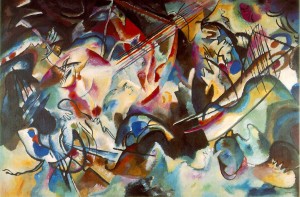Wassily Kandinsky was a Russian painter and art theorist. However, he initially was educated to become a teacher of law, ethnography and economics. He studied these subjects at the University of Moscow and taught for a few years before going to art school. He was one of the first people to experiment with abstract art and was influenced by the works of Monet and other impressionist painters. He studied art in both Russia and Munich, eventually developing a unique style. As Kandinsky worked through his style and further developed his art, he developed a theory of art. Some of this theory is expressed in “On the Spiritual in Art” where he discusses the difficulty in expressing emotion and feeling in art. He writes that some ‘pure’ artists are able to put spirituality in their art and communicate feelings through their art. To Kandinsky, this is the ultimate goal of art, it should be able to “intensify the observer’s sentimental mood and purify it”. He writes that the observer should recognize this as the meaning of art and devote significant time to the study of art and not browse through paintings casually, remarking on them as being ‘nice’ or ‘splendid’ ((Kandinsky, On the Spiritual in Art, 1946)).
Kandinsky’s influence on art was widespread, becoming one of the inspirations behind the field of Abstract Expressionism. He influenced many later artists, such as Jackson Pollack, with his theories on the expressive qualities of art, and how it should impact the viewer through all of the senses.
Kandinsky introduced a new way of looking at art, how did this impact the middle class? Did this make the general populace more appreciative of art? Or did the introduction of abstract art distance the general public from art?


